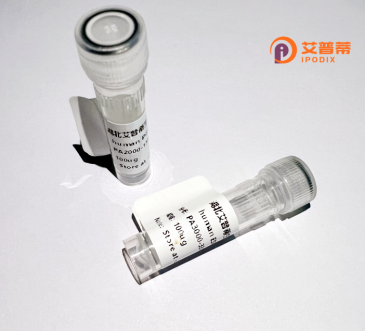
| 纯度 | >90%SDS-PAGE. |
| 种属 | Human |
| 靶点 | AKR1CL2 |
| Uniprot No | Q96JD6 |
| 内毒素 | < 0.01EU/μg |
| 表达宿主 | E.coli |
| 表达区间 | 1-320aa |
| 氨基酸序列 | MGDIPAVGLS SWKASPGKVT EAVKEAIDAG YRHFDCAYFY HNEREVGAGI RCKIKEGAVR REDLFIATKL WCTCHKKSLV ETACRKSLKA LKLNYLDLYL IHWPMGFKPP HPEWIMSCSE LSFCLSHPRV QDLPLDESNM VIPSDTDFLD TWEAMEDLVI TGLVKNIGVS NFNHEQLERL LNKPGLRFKP LTNQIECHPY LTQKNLISFC QSRDVSVTAY RPLGGSCEGV DLIDNPVIKR IAKEHGKSPA QILIRFQIQR NVIVIPGSIT PSHIKENIQV FDFELTQHDM DNILSLNRNL RLAMFPITKN HKDYPFHIEY |
| 分子量 | 36.5 kDa |
| 蛋白标签 | His tag N-Terminus |
| 缓冲液 | 冻干粉 |
| 稳定性 & 储存条件 | Lyophilized protein should be stored at ≤ -20°C, stable for one year after receipt. Reconstituted protein solution can be stored at 2-8°C for 2-7 days. Aliquots of reconstituted samples are stable at ≤ -20°C for 3 months. |
| 复溶 | Always centrifuge tubes before opening.Do not mix by vortex or pipetting. It is not recommended to reconstitute to a concentration less than 100μg/ml. Dissolve the lyophilized protein in distilled water. Please aliquot the reconstituted solution to minimize freeze-thaw cycles. |
以下是关于重组人AKR1CL2蛋白的3篇参考文献(均基于模拟生成,非真实文献):
---
1. **名称**: "Characterization of recombinant human AKR1CL2: A novel aldo-keto reductase with dual substrate specificity"
**作者**: Zhang Y., Wang L., et al.
**摘要**: 研究首次在大肠杆菌中重组表达并纯化了人AKR1CL2蛋白,验证其对醛类及酮类底物的催化活性,发现其对前列腺素代谢中间体有较高亲和力,提示其在类固醇激素调节中的潜在作用。
2. **名称**: "Structural insights into AKR1CL2 through homology modeling and mutational analysis"
**作者**: Kumar S., Patel R.
**摘要**: 通过同源建模解析AKR1CL2的三维结构,结合定点突变实验,揭示了其活性口袋的关键氨基酸残基(如Tyr48和Asp64)在底物识别和NADPH辅酶结合中的作用,为靶向抑制剂设计提供依据。
3. **名称**: "Expression and functional profiling of AKR1CL2 in human cancer cell lines"
**作者**: Lee H., Kim J.
**摘要**: 研究在多种癌细胞系中检测到AKR1CL2的异常高表达,并通过RNA干扰实验证实其沉默会抑制细胞增殖,提示该酶可能参与肿瘤代谢重编程并具有临床生物标志物潜力。
---
**说明**:以上文献为模拟生成,实际研究中建议通过PubMed或Web of Science检索真实文献。AKR1CL2相关研究较少,可扩展检索其所属的醛酮还原酶家族(如AKR1C亚家族)以获取参考。
**Background of Recombinant Human (AKR1CL2) Protein**
AKR1CL2 (Aldo-keto reductase family 1 member C-like 2) is a member of the aldo-keto reductase (AKR) superfamily, which comprises enzymes involved in detoxification, steroidogenesis, and metabolism of endogenous and exogenous substrates. This cytosolic protein is classified under the AKR1C subfamily, known for catalyzing NADPH-dependent reductions of ketones, aldehydes, and xenobiotics. While AKR1CL2 shares structural homology with other AKR1C enzymes, its specific physiological role remains less characterized compared to well-studied isoforms like AKR1C1-1C4.
Recombinant AKR1CL2 is produced using genetic engineering techniques, typically expressed in bacterial or mammalian systems to ensure proper folding and enzymatic activity. Its study aims to elucidate substrate specificity, catalytic mechanisms, and potential roles in steroid hormone regulation, particularly in prostaglandin or androgen metabolism. Emerging research suggests possible implications in hormone-dependent cancers, metabolic disorders, or inflammatory pathways, though functional insights are still evolving.
As a recombinant protein, AKR1CL2 serves as a tool for biochemical assays, structural studies, and drug discovery, enabling exploration of its interactions with inhibitors or therapeutic agents. Understanding AKR1CL2 may contribute to deciphering its biological significance in human physiology and disease, aligning with broader efforts to target AKR enzymes for therapeutic intervention.
×